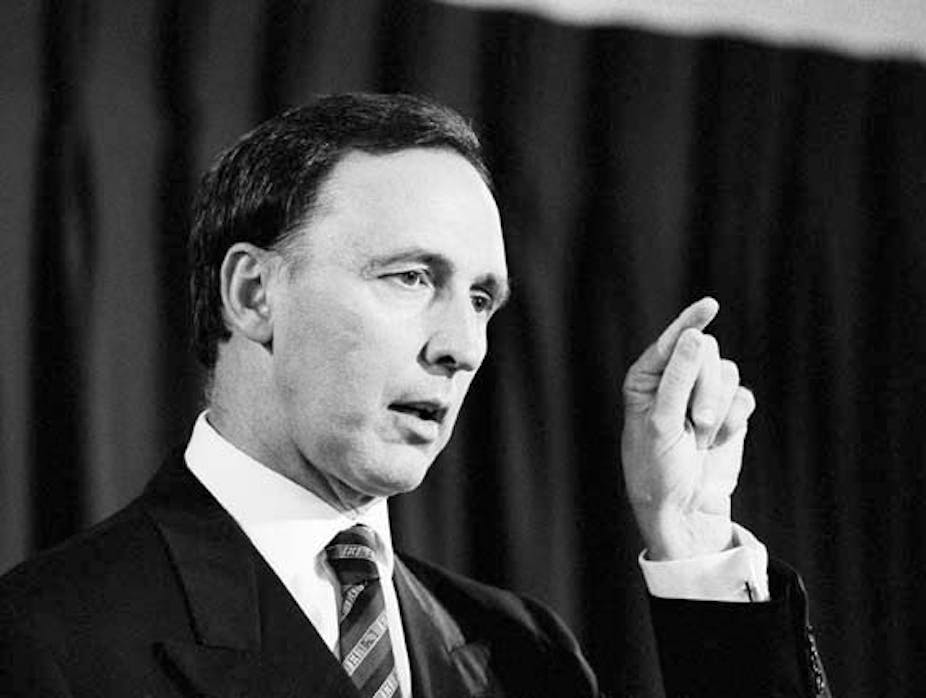A recent public poll showed that of Australia’s recent federal treasurers, Peter Costello and even John Howard were rated higher than Paul Keating. Joe Hockey was rated the worst.
Today’s release of the 1988 and 1989 Cabinet Papers by the National Archives, covering the middle years of the Hawke-Keating government, might remind us just what a mercurial treasurer Keating was. He was also - by far - the most industrious and visionary treasurer Australia has ever had. Ask any economic historian.
Keating handed down more budgets and economic statements than any other treasurer. His comment about being worn out by the time he won the keys to the Lodge rings true. Keating also had a visceral grasp of economics; however, it easily slipped into hubris and it was that which would prove his undoing.
Under his watch Australia underwent an economic revolution, transforming itself from a closed inward-looking economy to an internationalised one. Tariff cuts, asset sales, microeconomic reform, APEC, the current account deficit, corporatisation and deregulation, switching the policy levers; this was the economic lingo of that time. Some called it economic rationalism, but that phrase would become a pejorative one after the 1990 recession hit.
The Bicentennial year was the year when Keating brought down the budget he said would “bring home the bacon” - all the economic reforms Keating had engineered and invested in would pay dividends. He announced a mega-surplus of A$9 billion, - but as things turned out, his policy mix sowed the seeds that would end in a recession. Australia’s overriding problem at the time was a persistent current account deficit on its balance of payments.
The fashionable way to deal with it in economic theory terms was to amass public savings in the form of a budget surplus. This was the twin deficits hypothesis; the idea being that the two deficits were inextricably linked. Fiscal policy was kept tight as a drum while monetary policy was used for short-term stabilisation.
By 1989 this policy mix was under strain, with interest rates reaching double digit levels to quell an economic and asset boom. It would all end in tears. Instead of the soft landing Keating promised, the economy crashed. It’s likely that the ordinary punters equate Keating’s reign as treasurer with 18% mortgage interest rates, even higher for those with business loans.
Despite the “celebration of the nation” hoopla of the Bicentennial, Keating’s first cabinet memorandum for 1988 was in grim undertaker mode; he expressed forebodings about an economy still spending beyond its means. Keating wanted further reductions in public spending to achieve “a sustainable situation in our indebtedness to the rest of the world”.
Keating secured a commitment from the trade union movement for more responsible wage outcomes and this played their part in shaping a responsible economic policy. Keating pressed ahead with micro-economic reform. He announced a “mini budget” known as the May Economic Statement. The Hawke government committed itself to the largest tariff cut since Gough Whitlam’s infamous 25% cut in 1973. The Statement also cut business taxes, reduced government spending and reduction in assistance to the rural sector and deregulation of the telecommunications industry. The Hawke government was intent upon reducing assistance to manufacturing even though it had not been in the government’s electoral platform when first elected in 1983.
While industry minister, Senator John Button, welcomed the phased reductions in tariff assistance, he was beginning to think that there was not enough investment in building capacities to build things. While Button got Cabinet to offer grants to keep the Sarich orbital engine in Australia it was insufficient. In 1989, the Eastman Kodak film plant in Coburg decided to remain in Australia - but only after the Prime Minster intervened to offer more grant assistance. This went very much against the wishes of the Treasury.
In 1989 Keating informed cabinet that despite a recovery in export prices there was a danger of an inflationary boom and “a wage blowout”. Another mini budget was brought down, this time in April, with the states bearing the brunt of the cuts in reduced grants.
It was accompanied by further announcements on rationalisation of government business enterprises, lifting controls on their operations and enhancing their “market orientation”; asset sales were mooted starting with the government’s uranium stockpile, the Commonwealth Serum Laboratory and Cockatoo Island Dockyard. The more sensitive idea of selling off assets like the Commonwealth Bank, Telstra and Qantas would come in the 1990s.
The other significant import from these Cabinet papers was to act on an earlier green paper on higher education reform, specifically, to locate where the funding would come from to afford the sector’s expansion. In July 1988 Cabinet accepted the idea of ending the “isolation” of the tertiary education sector “from the major changes occurring in Australian society and the economy”. There were two aspects to this reform brought into play by federal education minister, John Dawkins.
Firstly, all tertiary institutions were to join a unified national system that would allow Canberra a greater purview over teaching, research and management. Colleges of Advanced Education would be transformed into universities with a few amalgamations along the way. There was a gold-rush of professorships in the offing.
The second part came in a submission in January 1989. Dawkins recommended to Cabinet the adoption of a Higher Education Contribution Scheme on the premise that domestic students, as beneficiaries of a university education, bear some of the costs through the tax system of their tuition. The Cabinet was heartened that public opinion supported the idea and moved to implement it. Changed days today, with the electorate not so keen in lumbering the young and beautiful with more tax debt.

